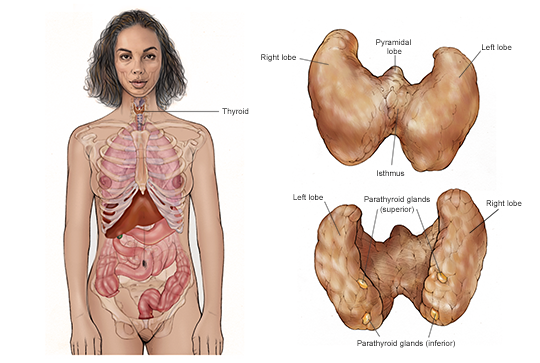Approved by the Cancer.Net Editorial Board, 08/2023
About the thyroid
Thyroid cancer begins in the thyroid gland. This gland is part of the endocrine system, which regulates hormones in the body. The thyroid gland absorbs iodine from the bloodstream to produce thyroid hormones to regulate the body’s metabolism.
The thyroid gland is located in the front of the neck, just below the larynx (voice box). A normal thyroid gland has 2 lobes, 1 on each side of the windpipe. The lobes are joined by a narrow strip of tissue called the isthmus.
A healthy thyroid gland is barely palpable, which means it is hard to find by touch. A swollen or enlarged thyroid is called a goiter. Most often, a goiter is not caused by cancer. Worldwide, goiters are most often caused by a lack of iodine in the diet. In the United States, most people get enough iodine from salt, so the most common cause of goiters is too much or too little thyroid hormone. Sometimes, the cause of a thyroid goiter is cancer. If a tumor develops in the thyroid, it is felt as a lump in the neck.

About thyroid tumors
Thyroid cancer starts when healthy cells in the thyroid change and grow out of control, forming a mass called a tumor. The thyroid gland contains 2 types of cells:
- Follicular cells are responsible for the production of thyroid hormone. Thyroid hormone controls the basic metabolism of the body. It controls how quickly calories are burned. This can affect weight loss, weight gain, how fast the heart beats, body temperature, how quickly food moves through the digestive tract, how muscles contract, and how quickly dying cells are replaced. Thyroid hormone is an essential hormone for many body functions and the body needs it to survive.
- C cells are special thyroid cells that make calcitonin, a hormone involved in calcium metabolism.
A tumor can be cancerous or benign. A cancerous tumor is malignant, meaning it can grow and spread to other parts of the body. A benign tumor means the tumor can grow but will not spread. Thyroid tumors can also be called nodules, and about 90% of all thyroid nodules are benign.
Types of thyroid cancer
There are 5 main types of thyroid cancer:
- Papillary thyroid cancer. Papillary thyroid cancer develops from follicular cells and usually grow slowly. It is the most common type of thyroid cancer. It is usually found in 1 lobe. About 10% to 20% of papillary thyroid cancer appears in both lobes. It is a differentiated thyroid cancer, meaning that the tumor looks similar to normal thyroid tissue under a microscope. Papillary thyroid cancer can often spread to lymph nodes.
- Follicular thyroid cancer. Follicular thyroid cancer also develops from follicular cells and usually grows slowly. Follicular thyroid cancer is also a differentiated thyroid cancer, but it is far less common than papillary thyroid cancer. Follicular thyroid cancer rarely spreads to lymph nodes.Follicular thyroid cancer and papillary thyroid cancer are the most common differentiated thyroid cancers. They are very often curable, especially when found early and in people younger than 50. Together, follicular and papillary thyroid cancers make up about 95% of all thyroid cancer.
- Hurthle cell cancer. Hurthle cell cancer, also called Hurthle cell carcinoma, is cancer that is arises from a certain type of follicular cell. Hurthle cell cancers are much more likely to spread to lymph nodes than other follicular thyroid cancers.
- Medullary thyroid cancer (MTC). MTC develops in the C cells and is sometimes the result of a genetic syndrome called multiple endocrine neoplasia type 2 (MEN2). This tumor has very little, if any, similarity to normal thyroid tissue. MTC can often be controlled if it is diagnosed and treated before it spreads to other parts of the body. MTC accounts for about 3% of all thyroid cancers. About 25% of all MTC is familial. This means that family members of the patient will have a possibility of a similar diagnosis. The RET proto-oncogene test (see Risk Factors) can confirm if family members also have familial MTC (FMTC).
- Anaplastic thyroid cancer. This type is rare, accounting for about 1% of thyroid cancer. It is a fast-growing, poorly differentiated thyroid cancer that may start from differentiated thyroid cancer or a benign thyroid tumor. Anaplastic thyroid cancer can be subtyped into giant cell classifications. Because this type of thyroid cancer grows so quickly, it is more difficult to treat successfully.
In addition, other types of cancer may start in or around the thyroid gland. For lymphoma in the thyroid, read Cancer.Net’s Guide to Non-Hodgkin Lymphoma. For more information on sarcoma in the thyroid, read the Cancer.Net Guide to Sarcoma. For information on a tumor in the nearby parathyroid gland, read Cancer.Net’s Guide to Parathyroid Cancer.